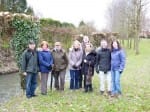Caesar, Spartacus, and NATO
 Earlier this month, I had the privilege of taking a staff ride to the site of one of Julius Caesar’s battles in Gaul. It was part of my visit to SHAPE in Mons, Belgium, where I was invited to lecture on military history. SHAPE (Supreme Headquarters, Allied Powers in Europe) is NATO’s military wing. My companions on the staff ride were allied officers, civilian officials, and their families from three countries – and a better group could not be imagined.
Earlier this month, I had the privilege of taking a staff ride to the site of one of Julius Caesar’s battles in Gaul. It was part of my visit to SHAPE in Mons, Belgium, where I was invited to lecture on military history. SHAPE (Supreme Headquarters, Allied Powers in Europe) is NATO’s military wing. My companions on the staff ride were allied officers, civilian officials, and their families from three countries – and a better group could not be imagined.
I spoke in NATO’s “Notable Authors” series. My topic was Spartacus and the lessons of his revolt for insurgency and counter-insurgency today. You can read about it here (http://blogs.cornell.edu/theessentials/2011/02/14/charisma/) and here (http://aco.nato.int/page300401933.aspx). Spartacus is a true tale for the times, but the staff ride had a timeless appeal.
We were looking for the site of the Battle of the Sabis in 57 B.C. One of the highlights of Caesar’s Gallic Wars is his description of this clash in Book II. A surprise attack across a river by the fierce Belgae caught the Romans unprepared as they were setting up camp on the high ground opposite. As Caesar tells it, only the training that he had given his officers saved the day – that, and his own heroic presence on the front lines. Well, Caesar was a politician, and he knew that elections are not won by modesty.
In any case, it’s a gripping account, but it does leave open the question of precisely where the battle took place. It was certainly in northern France, near the Belgian border, but scholars disagree about the specific spot. Three rivers have been put forth as the one along whose banks the battle raged: the Sambre, the Escaut, and the Selle. The case isn’t clinched but the arguments for the Selle are the strongest.
So my colleagues and I headed for that river and spent a delightful few hours tromping around the fields outside the town of Saulzoir. I’ll save the details for another time. Suffice it to say that it made a very plausible battle site.
Afterwards, we headed northeast, following the old Roman road, to the town of Bavay. There we were rewarded with the ruins of a Roman forum (centuries later than Julius Caesar), an excellent little museum with a superb collection of Roman bronzes, and a very charming French restaurant.
Scholarship is tough.